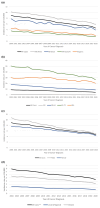Trends in the Incidence and Survival Outcomes in Patients With Small Cell Lung Cancer in the United States: An Analysis of the SEER Database
- PMID: 39908169
- PMCID: PMC11797299
- DOI: 10.1002/cam4.70608
Trends in the Incidence and Survival Outcomes in Patients With Small Cell Lung Cancer in the United States: An Analysis of the SEER Database
Abstract
Background: There has been a lack of updated epidemiological data on the incidence and survival outcomes for patients with small cell lung cancer (SCLC) in the United States over the last two decades.
Methods: A retrospective, population-based study was conducted utilizing the Surveillance, Epidemiology, and End Results (SEER) program to identify patients with SCLC from 2000 to 2020. Trends in cancer incidence, incidence-based mortality rates, 1-year relative survival rates and 1-year observed survival were evaluated utilizing the SEER database.
Results: The database identified a total of 188,426 SCLC patients during the study period from 2000 through 2020. The age-adjusted incidence rate slowly declined, on average, by 3% (95% CI: -3.2% to -2.8%) each year from 9 per 100,000 in 2000 to 4.6 per 100,000 in 2020. The decline is evident for all age groups, sexes, and races. Incidence-based mortality also declined slowly from 6.6 in 2005 to 3.5 in 2020. However, survival outcomes, including 1-year relative survival and 1-year observed survivals, have not improved significantly over the last two decades.
Conclusion: This study found that the incidence of SCLC has decreased from 2000 to 2020, likely due to a reduction in smoking rates, underscoring the importance of smoking abstinence. An improvement in incidence-based mortality is likely related to an enhanced medical care and a decrease in the incidence of SCLC, but the lack of improvement in survival outcomes reflects the need for more effective systemic therapy.
Keywords: SCLC; SEER; epidemiology; lung cancer; population; small‐cell.
© 2025 The Author(s). Cancer Medicine published by John Wiley & Sons Ltd.
Conflict of interest statement
Advisory Board/ Consulting fees for Daiichi Sankyo, Sanofi, Astrazaneca, and Jazz Pharmaceuticals. Research Consultant: Pfizer;
Figures



Similar articles
-
The changing landscape of small cell lung cancer.Cancer. 2024 Jul 15;130(14):2453-2461. doi: 10.1002/cncr.35281. Epub 2024 Mar 12. Cancer. 2024. PMID: 38470453
-
Changing epidemiology of elderly small cell lung cancer patients over the last 40 years; a SEER database analysis.Clin Respir J. 2018 Mar;12(3):1093-1099. doi: 10.1111/crj.12632. Epub 2017 Apr 12. Clin Respir J. 2018. PMID: 28371208
-
Large-Cell Neuroendocrine Carcinoma of the Lung: A Population-Based Study.Clin Lung Cancer. 2020 Mar;21(2):e99-e113. doi: 10.1016/j.cllc.2019.07.011. Epub 2019 Aug 3. Clin Lung Cancer. 2020. PMID: 31601526
-
Cancer of the Larynx-20-Year Comparative Survival and Mortality Analysis by Age, Sex, Race, Stage, Grade, Cohort Entry Time-Period, Disease Duration and ICD-O-3 Topographic Primary Sites-Codes C32.0-9: A Systematic Review of 43,103 Cases for Diagnosis Years 1975-2017: (NCI SEER*Stat 8.3.9).J Insur Med. 2024 Jul 1;51(2):92-110. doi: 10.17849/insm-51-2-92-110.1. J Insur Med. 2024. PMID: 39266004
-
Cancer of the Nasal Cavity, Middle Ear and Accessory Sinuses - 15 Year Comparative Survival and Mortality Analysis by Age, Sex, Race, Stage, Grade, Cohort Entry Time-Period, Disease Duration and Topographic Primary Sites: A Systematic Review of 13,404 Cases for Diagnosis Years 2000-2017: (NCI SEER*Stat 8.3.8).J Insur Med. 2024 Jul 1;51(2):77-91. doi: 10.17849/insm-51-2-77-91.1. J Insur Med. 2024. PMID: 39266003
Cited by
-
Acute pancreatitis secondary to small-cell lung cancer metastasis: A case report and literature review.World J Clin Cases. 2025 Sep 26;13(27):107805. doi: 10.12998/wjcc.v13.i27.107805. World J Clin Cases. 2025. PMID: 40881889
-
Current and Emerging Therapeutic Strategies for Limited- and Extensive-Stage Small-Cell Lung Cancer.Med Sci (Basel). 2025 Aug 18;13(3):142. doi: 10.3390/medsci13030142. Med Sci (Basel). 2025. PMID: 40843764 Free PMC article. Review.
-
Redefining the Fight Against SCLC: Standards, Innovations, and New Horizons.Cancers (Basel). 2025 Jul 7;17(13):2256. doi: 10.3390/cancers17132256. Cancers (Basel). 2025. PMID: 40647553 Free PMC article. Review.
References
-
- Govindan R., Page N., Morgensztern D., et al., “Changing Epidemiology of Small‐Cell Lung Cancer in the United States Over the Last 30 Years: Analysis of the Surveillance, Epidemiologic, and End Results Database,” Journal of Clinical Oncology 24, no. 28 (2006): 4539–4544, 10.1200/JCO.2005.04.4859. - DOI - PubMed
-
- Okamoto H., Watanabe K., Nishiwaki Y., et al., “Phase II Study of Area Under the Plasma‐Concentration‐Versus‐Time Curve‐Based Carboplatin Plus Standard‐Dose Intravenous Etoposide in Elderly Patients With Small‐Cell Lung Cancer,” Journal of Clinical Oncology 17, no. 11 (1999): 3540–3545, 10.1200/JCO.1999.17.11.3540. - DOI - PubMed
-
- Hanna N., P. A. Bunn, Jr. , Langer C., et al., “Randomized Phase III Trial Comparing Irinotecan/Cisplatin With Etoposide/Cisplatin in Patients With Previously Untreated Extensive‐Stage Disease Small‐Cell Lung Cancer,” Journal of Clinical Oncology 24, no. 13 (2006): 2038–2043, 10.1200/JCO.2005.04.8595. - DOI - PubMed
-
- Paz‐Ares L., Dvorkin M., Chen Y., et al., “Durvalumab Plus Platinum‐Etoposide Versus Platinum‐Etoposide in First‐Line Treatment of Extensive‐Stage Small‐Cell Lung Cancer (CASPIAN): A Randomised, Controlled, Open‐Label, Phase 3 Trial,” Lancet 394, no. 10212 (2019): 1929–1939, 10.1016/S0140-6736(19)32222-6. - DOI - PubMed
MeSH terms
LinkOut - more resources
Full Text Sources
Medical

